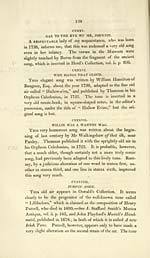Glen Collection of printed music > Printed text > Illustrations of the lyric poetry and music of Scotland
(309) Page 129 - Hap me with thy pettycoat
Download files
Complete book:
Individual page:
Thumbnail gallery: Grid view | List view

CXXXVIII. JUMPIN JOHN.
129
of Lilliburlero was common both in Scotland and England be-
fore Purcell was born ; the title of the song was the pass-word
used among the Papists in Ireland at the horrible massacre
of the Protestants in 1641. The tune itself was printed in
Playford's Dancing-Master in 1657, under the title of " Joan's
Placket," and Purcell was only born in the year 1658. The
notes of the air are subjoined.
JUMPIN' JOHN; OR, JOAN'S PLACKET.
From Playford's Dancing-Matter, ^printed in 1657.
To this air also an Anglo-Irish song, beginning " Ho !
broder Teague, do'st hear the decree,"" was adapted in 1686,
which made such an impression on the royal army, as to con-
tribute greatly towards the Revolution in 1688.
The two humorous stanzas, beginning " Her daddie for-
bad," to which the tune of " Jumpin' John" are united in
the Museum, were communicated by Burns. They are a
fragment of the old humorous ballad, with some verbal cor-
rections.
CXXXIX
HAP ME WITH THY PETTYCOAT.
Mr Tytler, in his very ingenious and masterly Disser-
tation on Scottish Music, observes, that " the distinguish-
ing strain (character) of our old melodies is plaintive
melancholy; and what makes them soothing and affect-
ing to a great degree, is the constant use of the concordant
tones, the third and fifth of the scale, often ending upon the
fifth, and some of them on the sixth of the scale. By this
artless standard some of our Scottish melodies may be traced,
such as. Gill Morrice — There came a Ghost to Margarets
Door — Laddie I maun he thee — Hap me wi' thy Petti-
coat. I mean the old sets of these airs ; as the last air, which
129
of Lilliburlero was common both in Scotland and England be-
fore Purcell was born ; the title of the song was the pass-word
used among the Papists in Ireland at the horrible massacre
of the Protestants in 1641. The tune itself was printed in
Playford's Dancing-Master in 1657, under the title of " Joan's
Placket," and Purcell was only born in the year 1658. The
notes of the air are subjoined.
JUMPIN' JOHN; OR, JOAN'S PLACKET.
From Playford's Dancing-Matter, ^printed in 1657.
To this air also an Anglo-Irish song, beginning " Ho !
broder Teague, do'st hear the decree,"" was adapted in 1686,
which made such an impression on the royal army, as to con-
tribute greatly towards the Revolution in 1688.
The two humorous stanzas, beginning " Her daddie for-
bad," to which the tune of " Jumpin' John" are united in
the Museum, were communicated by Burns. They are a
fragment of the old humorous ballad, with some verbal cor-
rections.
CXXXIX
HAP ME WITH THY PETTYCOAT.
Mr Tytler, in his very ingenious and masterly Disser-
tation on Scottish Music, observes, that " the distinguish-
ing strain (character) of our old melodies is plaintive
melancholy; and what makes them soothing and affect-
ing to a great degree, is the constant use of the concordant
tones, the third and fifth of the scale, often ending upon the
fifth, and some of them on the sixth of the scale. By this
artless standard some of our Scottish melodies may be traced,
such as. Gill Morrice — There came a Ghost to Margarets
Door — Laddie I maun he thee — Hap me wi' thy Petti-
coat. I mean the old sets of these airs ; as the last air, which
Set display mode to: Large image | Transcription
Images and transcriptions on this page, including medium image downloads, may be used under the Creative Commons Attribution 4.0 International Licence unless otherwise stated. ![]()
| Special collections of printed music > Glen Collection of printed music > Printed text > Illustrations of the lyric poetry and music of Scotland > (309) Page 129 - Hap me with thy pettycoat |
|---|
| Permanent URL | https://digital.nls.uk/91320877 |
|---|
| Description | Scottish songs and music of the 18th and early 19th centuries, including music for the Highland bagpipe. These are selected items from the collection of John Glen (1833 to 1904). Also includes a few manuscripts, some treatises, and other books on the subject. |
|---|
| Description | The Glen Collection and the Inglis Collection represent mainly 18th and 19th century Scottish music, including Scottish songs. The collections of Berlioz and Verdi collected by bibliographer Cecil Hopkinson contain contemporary and later editions of the works of the two composers Berlioz and Verdi. |
|---|

